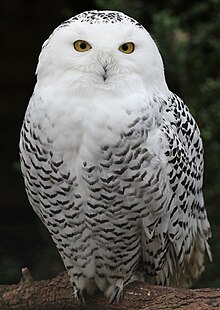Afroaves

| Afroaves Temporal range: Paleocene to present | |
|---|---|
 | |
| Snowy owl, Bubo scandiacus | |
| Scientific classification | |
| Domain: | Eukaryota |
| Kingdom: | Animalia |
| Phylum: | Chordata |
| Class: | Aves |
| Clade: | Telluraves |
| Clade: | Afroaves Ericson, 2012 |
| Subclades | |
Afroaves is a clade of birds, consisting of the kingfishers and kin (Coraciiformes), woodpeckers and kin (Piciformes), hornbills and kin (Bucerotiformes), trogons (Trogoniformes), cuckoo roller (Leptosomiformes), mousebirds (Coliiformes), owls (Strigiformes), raptors (Accipitriformes) and New World vultures (Cathartiformes).[1][2] The most basal clades are predatory, suggesting the last common ancestor of Afroaves was also a predatory bird.[2] This group was defined in the PhyloCode by George Sangster and colleagues in 2022 as "the least inclusive crown clade containing Accipiter nisus, Colius colius, and Picus viridis, but not Passer domesticus".[3]
Phylogeny
[edit]The following cladogram of Afroaves relationships is based on Jarvis et al (2014),[2] with some clade names after Yury, T. et al. (2013)[4] and Kimball et al. (2013).[5]
| Afroaves |
| |||||||||||||||||||||||||||||||||||||||||||||||
Afroaves has not always been recovered as a monophyletic clade in subsequent studies. For instance, Prum et al. (2015) recovered the accipitrimorphs as the sister group to a clade (Eutelluraves) comprising the remaining afroavian orders and Australaves,[6] while an analysis by Houde et al. (2019) recovered a clade of accipitrimorphs and owls as sister to the remaining landbirds.[7] Wu et al. (2024) also found recovered and found support the clade of accipitrimorphs and owls (which they have named Hieraves), but found the clade to be sister to Australaves.[8] Kukl et al. (2020) obtained an identical arrangement to Jarvis et al. (2014) but the position of the Strigiformes was only weakly supported by their data.[9] Stiller et al. (2024) recovered the Afroaves as a clade but with the Strigiformes as sister to the Accipitrimorphae, rather than sister to the Coraciimorphae as in the Jarvis tree. Stiller et al. (2024) found that the support for their placement of the Strigiformes increased when additional taxa were included in the analysis.[10]
| Jarvis et al. (2014)[2] |
|---|
| Prum et al. (2015)[6] | |||||||||
|---|---|---|---|---|---|---|---|---|---|
|
| Houde et al (2019)[7] |
|---|
| Wu et al (2024)[8] |
|---|
| Stiller et al (2024)[10] |
|---|
References
[edit]- ^ Ericson, P.G. (2012). "Evolution of terrestrial birds in three continents: biogeography and parallel radiations" (PDF). Journal of Biogeography. 39 (5): 813–824. Bibcode:2012JBiog..39..813E. doi:10.1111/j.1365-2699.2011.02650.x. S2CID 85599747.
- ^ a b c d Jarvis, E. D.; Mirarab, S.; Aberer, A. J.; Li, B.; Houde, P.; Li, C.; Ho, S. Y. W.; Faircloth, B. C.; Nabholz, B.; Howard, J. T.; Suh, A.; Weber, C. C.; Da Fonseca, R. R.; Li, J.; Zhang, F.; Li, H.; Zhou, L.; Narula, N.; Liu, L.; Ganapathy, G.; Boussau, B.; Bayzid, M. S.; Zavidovych, V.; Subramanian, S.; Gabaldon, T.; Capella-Gutierrez, S.; Huerta-Cepas, J.; Rekepalli, B.; Munch, K.; et al. (2014). "Whole-genome analyses resolve early branches in the tree of life of modern birds" (PDF). Science. 346 (6215): 1320–1331. Bibcode:2014Sci...346.1320J. doi:10.1126/science.1253451. hdl:10072/67425. PMC 4405904. PMID 25504713. Archived from the original (PDF) on 2015-02-24. Retrieved 2015-08-29.
- ^ Sangster, George; Braun, Edward L.; Johansson, Ulf S.; Kimball, Rebecca T.; Mayr, Gerald; Suh, Alexander (2022-01-01). "Phylogenetic definitions for 25 higher-level clade names of birds" (PDF). Avian Research. 13: 100027. Bibcode:2022AvRes..1300027S. doi:10.1016/j.avrs.2022.100027. ISSN 2053-7166.
- ^ Yuri, T.; et al. (2013). "Parsimony and Model-Based Analyses of Indels in Avian Nuclear Genes Reveal Congruent and Incongruent Phylogenetic Signals". Biology. 2 (1): 419–444. doi:10.3390/biology2010419. PMC 4009869. PMID 24832669.
- ^ Kimball, R.T. et al. (2013) Identifying localized biases in large datasets: A case study using the Avian Tree of Life. Mol Phylogenet Evol. doi:10.1016/j.ympev.2013.05.029
- ^ a b Prum, R.O. et al. (2015) A comprehensive phylogeny of birds (Aves) using targeted next-generation DNA sequencing. Nature 526, 569–573.
- ^ a b Houde, Peter; Braun, Edward L.; Narula, Nitish; Minjares, Uriel; Mirarab, Siavash (2019). "Phylogenetic Signal of Indels and the Neoavian Radiation". Diversity. 11 (7): 108. doi:10.3390/d11070108. ISSN 1424-2818.
- ^ a b Wu, S.; Rheindt, F.E.; Zhang, J.; Wang, J.; Zhang, L.; Quan, C.; Zhiheng, L.; Wang, M.; Wu, F.; Qu, Y; Edwards, S.V.; Zhou, Z.; Liu, L. (2024). "Genomes, fossils, and the concurrent rise of modern birds and flowering plants in the Late Cretaceous". Proceedings of the National Academy of Sciences. 121 (8). doi:10.1073/pnas.2319696121. PMC 10895254.
- ^ Kuhl, H.; Frankl-Vilches, C.; Bakker, A.; Mayr, G.; Nikolaus, G.; Boerno, S.T.; Klages, S.; Timmermann, B.; Gahr, M. (2021). "An unbiased molecular approach using 3′-UTRs resolves the avian family-level tree of life". Molecular Biology and Evolution. 38 (1): 108–127. doi:10.1093/molbev/msaa191. hdl:21.11116/0000-0007-B72A-C.
- ^ a b Stiller, J.; et al. (2024). "Complexity of avian evolution revealed by family-level genomes". Nature. 629: 851–860. doi:10.1038/s41586-024-07323-1. PMC 11111414.



